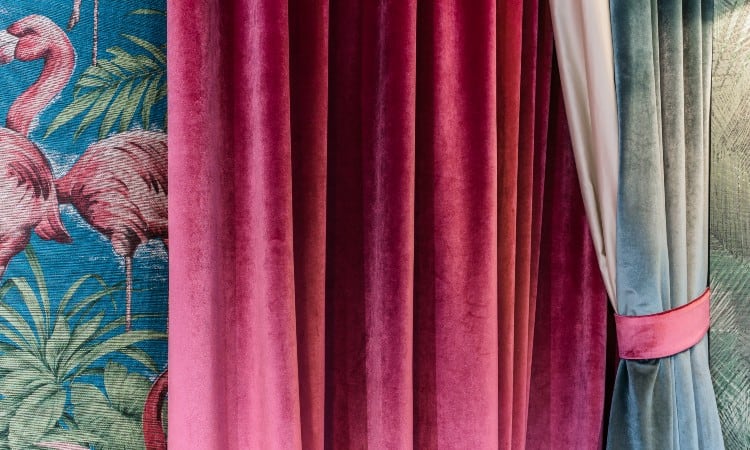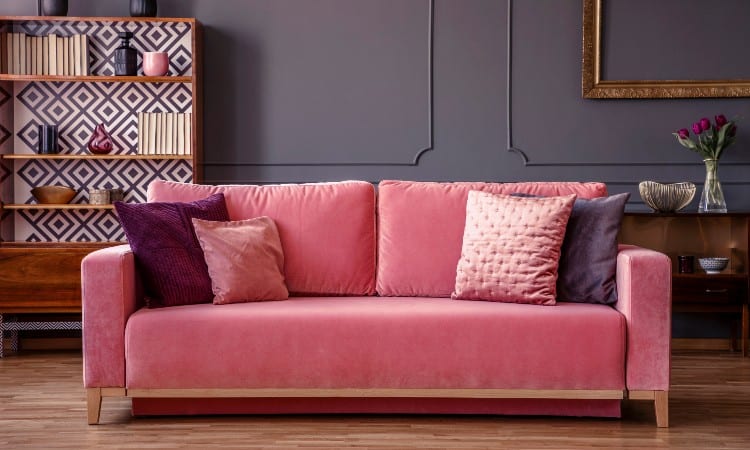I have some bottle green velvet. Although it’s a nice shade, it doesn’t go with anything I own. I’m thinking about dyeing it a different color. Is that possible? Can you dye velvet?
Velvet fabric can be dyed. The success of the dyeing process depends on the fiber content. A velvet made from natural fibers like cotton will dye easily. Synthetic velvet made from nylon can be dyed. So too can a synthetic blend. However, dyeing velvet containing polyester fibers is nearly impossible. Polyester is hydrophobic and impervious to many dyes.
In this article, we’ll look at the different dyes available for velvet. We’ll also take a look at which types of velvet can be dyed.

Quick Navigation
Can You Dye Velvet?
Yes, you can dye velvet, although the success you have will depend a lot on the fiber content of the velvet you are working with.
Velvet has always been associated with opulence and luxury. Originally velvet would have been made from silk and was incredibly expensive. It would have been a fashion staple reserved for nobility and royalty.
All that has changed, though. Velvet is no longer an exclusive product for the rich and famous.
These days velvet is a lot more affordable and easily acquired by the masses like you and me.
This is down to the fibers it can be made from. You see, it’s no longer a fabric made solely from silk. You can find velvet made from polyester, nylon, rayon, and cotton.
It’s quite rare to find a 100% silk velvet anymore. The cost is just too prohibitive. You’re more likely to find a rayon/silk blend. While this is great news for our wallets, it can be bad news if you want to dye your velvet.
Knowing the fiber content of your velvet is a key factor in whether your fabric can be dyed or not. What you are looking for is a fabric that contains a high percentage of natural fiber material.
Natural fibers like cotton and silk are a lot easier to dye. Regardless of the type of material, they are woven into. It’s just the nature of a natural product. Cotton, for instance, is one of the most absorbent materials around, which means it can suck up dye like a sponge.
Synthetic fibers like nylon can be dyed but not quite so easily. They require special dyes designed for artificial fibers. Some synthetics like polyester are problematic when it comes to dyeing fabric.
Polyester is hydrophobic, so it won’t absorb any moisture. As dyes tend to be water-based, this can be more than a little bit of an inconvenience. If your velvet dress contains any polyester, even if it’s just the thread, dyeing it successfully will be almost impossible.
One thing you do need to bear in mind with dyeing velvet is the fabric texture. Velvet is a fabric
with a pile. This pile can appear differently in the many styles of velvet. It can be crushed, embossed, or plain.
Each type creates a patterned effect. Dyeing velvet can change the appearance of this pattern by flattening the pile. Not only will the color change, but you’ll also change the look and feel of the velvet.
Why Dye Velvet?

There are many reasons why it’s a good idea to dye velvet. You’ve probably heard people say everything looks better with a fresh coat of paint? Well, the same principle applies to clothes and furniture.
Although home décor styles can change, it’s the color of the item that dates your belongings. Take your sofa or your lounge curtains. If either one is a dark shade of green, you’ll have people thinking they date back to the 70s.
That’s the problem with fashion. What was once a popular shade in the 1970s, for instance, will look tired and out of place today. The same can also be said for colors from last year.
By refreshing your furnishings with a vibrant, bang-up-to-the-minute shade, you can add new life to your favorite velvet cushions, curtains, and sofa. Rejuvenating your velvet with one of the latest hues will take years off them. Better still, that 1970s sofa you bought at a thrift store will be back on-trend.
Of course, modernizing velvet isn’t the only reason to dye it a different shade. You might have a crushed velvet dress in a cool shade of sky blue. But light blue isn’t your color. So you don’t wear a dress even though the style is flattering.
Dyeing the velvet gives you the opportunity to express yourself with a shade better suited to you and your personality. How about a voluptuous purple? Or a sensual red? It’s all possible when you dye your velvet. Instead of being consigned to the deepest depths of your closet, that dress could make you look like a million dollars. All for the cost of a bottle of dye.
Velvet is one of those fabrics that can be difficult to clean. Stubborn marks can take some shifting. So why bother? You can cover up the hard-to-remove grime by dyeing the velvet. It’s a simple case of choosing a darker shade, or you could even use the same hue to cover up the icky spots. This works for furnishings with food spills or even pen marks on your velvet jacket.
What Dyes Work on Velvet?
 When it comes to dyeing velvet, you have a range of commercially produced dyes to choose from. The reason for the large selection is velvet can be made from natural or synthetic material.
When it comes to dyeing velvet, you have a range of commercially produced dyes to choose from. The reason for the large selection is velvet can be made from natural or synthetic material.
As the fiber content of velvet can range from nylon to cotton with a choice of blends in between, you have to know what fibers you’re dealing with to get the right dye.
Natural and synthetic fibers behave differently when you dye them. While a natural fiber will absorb dye and take to the color readily, synthetic fibers won’t. You need to use a specific dye suitable for synthetics. This can be a problem as natural fibers don’t tend to take to dyes meant for artificial yarns.
However, all is not lost. The key to getting the best dye is knowing what percentage of synthetic or natural fibers your velvet contains. If your velvet has more than 35% synthetic content, use a dye designed for artificial fibers. For blended materials containing less than 35% synthetic yarns, use an all-purpose dye suitable for natural fibers.
With this in mind, let’s take a look at some of the dyes available on the market. This will help you figure out which one will give you the best results.
1. Natural Dye
As the name suggests, this type of dye is a natural product and is suitable for use on natural fiber textiles. So if your velvet is mainly cotton, this could be the dye for you.
These dyes are normally plant or mineral-based and can be made from roots, wood, berries, lichens, and even nuts. You can even make a natural dye from turmeric, nettles, and onions.
2. Acid Dye
These are concentrated hot water dyes that work well on protein fibers and synthetic polymers. So, your velvet needs to be made from animal-based fibers like wool and silk. Or synthetics like nylon.
Although they are known as acid dyes, the acid contained is relatively mild. It’s normally either vinegar or citric acid.
3. Procion MX
A Procion MX dye is a versatile dye you can use for most velvets. If you use it as a concentrate mixed with cold water, it can dye cellulose fibers. This includes cotton and viscose. You might know viscose better than rayon.
Using Procion MX with acid in a hot water bath enables you to dye wool. Better still, the hot water and acid mix mean you can use it to dye nylon too!
4. Bleach
Although you can bleach velvet to change its color, you have to be careful with the fiber content. This method only really works well with cotton. Synthetics and synthetic blends don’t play nicely with bleach and you may ruin your velvet.
The effects you can create by bleaching a cotton velvet can be impressive. The bleach can change the texture of the material and the color, giving you a unique and individual result.
5. Disperse Dye
If you are dealing with velvet with a polyester content, you will have to use a disperse dye. Polyester is impervious to moisture and can’t soak up water-based dyes.
A disperse dye works with intense heat to separate the fibers in a fabric. As they move apart, the dye seeps in between them, thus allowing the color to penetrate the depths of the fabric.
As the material cools and shrinks back into place, the color is trapped between the fibers. Hence it’s dispersed throughout the textile rather than covering it.
How to Dye Velvet
Now you know what dye you should be using, the next thing to look at is how to dye your velvet. As with dyes, there are a couple of options to choose from. The one you use will be determined by the item you want to dye.
Whether you’re dyeing furniture, clothing, cushions, or curtains, always read the instructions on your dye’s packaging. Making sure you use the right dye for your velvet will ensure you get a successful result.
Velvet Dress

Dresses and clothing, in general, can be dyed either in a washing machine or by hand. Check the care label of your garment to find out the fiber content before attempting to dye your velvet. You need to make sure you get the right dye for the fabric.
For this example, we will assume the velvet dress has a high nylon content. Therefore, the following steps will cover using an acid dye at high heat.
You will need:
- Acid dye
- Large cooking pot
- Rubber gloves
- Laundry tongs
- Thermometer
- Kitchen scales
- Vinegar or citric acid
Step 1
Check your acid dye packaging to see if you need to know how heavy your dress is. Some dyes require you to measure the amount of acid you use in your dye. Normally it’s between 1 tablespoon or 1/4 cup per pound of fabric, depending on what acid you use.
Step 2
Make sure the velvet dress is completely clean by washing it according to the instructions on the care label. You can do this by hand or in a washing machine. Don’t dry the dress once the wash cycle has finished. It has to be wet for the next steps.
Step 3
Bring a large cooking pot of water to the boil on your stove. Reduce the heat to a medium setting. The pot needs to be big enough to completely cover your dress and allow room for it to be swirled about inside the pot.
Step 4
Check the instructions on your package of acid dye to find out how much to add to the boiling water. You may have to mix some dye with one cup of hot water before adding it to your cooking pot. Stir it with your laundry tongs to make sure the dye is thoroughly dissolved.
Step 5
Pop your wet velvet dress into the cooking pot and squish it under the water with your laundry tongs. Give it a twirl to make sure it’s completely soaked in dye. You need to wear your rubber gloves for this stage to protect your hands. Your clothing may look great in a new shade of purple, but you don’t want your hands the same color!
Step 6
You’ll find the water will cool a little when you add the dress. Bring the water back up to a temperature of around 185ºF. Add your acid to the mix. Double-check your dye packaging for the correct amount of acid for your dye.
Step 7
Keep the water at a constant 185ºF for 30-60 minutes. The longer you leave the garment, the darker the shade will be. For a light, subtle shade, aim for no more than 30 minutes. Remember to give the garment a stir at regular intervals throughout the dyeing process.
Step 8
After the time has elapsed, remove the velvet dress from the cooking pot. Use your laundry tongs and rubber gloves as the dress will be hot. Rinse the garment in warm water until it runs clear.
Step 9
Wash your dress on a cool, regular cycle in your washing machine. Allow to air dry. Reshape the garment while still damp and fluff the nap with a soft brush.
Velvet Furniture

This method is ideal for when you want to dye the velvet covers on your sofa or chairs. Make sure you choose a fabric dye suitable for your velvet upholstery. You want to make sure it’s not going to rub off on your clothing when you sit on your furniture!
You will need:
- Dye suitable for velvet upholstery
- Masking tape
- Plastic drop cloths
- 2 Sponges
- Bucket of warm water
- Soft upholstery brush
Step 1
The first thing to do is protect the parts of your furniture you don’t want to dye. Completely cover the wooden areas like the legs and arms with plastic drop cloths. Hold the plastic down with masking tape. You could also use duct tape for this, but be careful to only stick the tape to the plastic sheeting, not the wood or the chair coverings! You don’t want to damage the velvet or pull the varnish off your wood surfaces.
Step 2
Using the sponge, give your sofa or chair a quick bath. Make sure all the velvet areas are given liberal dosing of water. You want just enough water to make the surface feel damp.
Step 3
Check the instructions on your dye packaging and mix the dye as directed. Then using a dry sponge, apply the dye to the velvet. Work in circles from one side of the chair or sofa to the other. Keep working in a circular motion until the fabric is completely covered with dye.
Step 4
Leave your furniture to dry for a minimum of 24 hours. Once it’s dry, you may find the nap has been flattened by the dye. If this is the case, use a soft upholstery brush to fluff the velvet fibers back up. Alternatively, you can sponge a small amount of warm water across the surface and allow it to dry.
Velvet Curtains and Cushion Covers
Curtains and cushion covers have something in common with clothing. They can be put in a washing machine or dyed by hand too! As we looked at acid dyes in the last example, this time, we’ll cover dyeing a rayon velvet with Procion MX dye in a washing machine.
You will need:
- Procion MX dye
- Washing machine
- Kitchen scales
- Soda ash
Step 1
As with the acid dye method, weigh your velvet before starting the dyeing process. Write the weight down and keep it close by to refer to it later.
Step 2
Make sure the curtains or cushion covers are clean by brushing them with a soft brush to loosen any dirt. If any marks or stains remain, wash the items on a regular machine setting. Don’t dry them. Remove them from the machine and shake them out.
Step 3
Read the instructions on the packaging of your Procion dye. Dissolve the dye as directed by the manufacturer.
Step 4
Put your wet velvet back in the machine. Refer to the dye manufacturer’s instructions for machine settings and when to add the dye. It’s usually a cool setting. Add the dissolved dye and 2 tablespoons of soda ash.
Step 5
After the dyeing process is complete, wash the velvet on a regular setting to remove any residual dye. This will also help clean out your machine. Remove the items once the cycle is complete and allow them to air dry. While waiting, put your machine through one more wash cycle to make sure all the dye has been cleaned out.
Can You Tie Dye Velvet?
 You can tie-dye velvet, particularly if it’s a natural fiber velvet or one with a low percentage of synthetic material. However, you do need to be a bit cautious.
You can tie-dye velvet, particularly if it’s a natural fiber velvet or one with a low percentage of synthetic material. However, you do need to be a bit cautious.
Velvet is a fabric with a raised pile that gives the fabric its famous velvety shine and soft feel. It’s easily squashed, though. Any rough treatment, particularly when it’s wet, can damage the pile. If you flatten or crush the pile, the velvet will look duller.
As dyeing velvet involves getting the fabric wet, this can make tie-dyeing problematic. To tie-dye a material, you need to tie it in knots or twirls. You can also fold it into a concertina shape.
While it’s not impossible to tie velvet into twirls or fold it up, do so carefully without applying too much pressure. Never wring or twist the velvet into your preferred shape. Go slowly and use a gentle hand.
Can You Dye Polyester Velvet?
You can dye polyester velvet, but it isn’t going to be easy. Polyester is an incredibly difficult material to dye, especially 100% polyester.
As it’s hydrophobic, polyester doesn’t absorb water. This is one of its strengths and makes it a fantastic textile for waterproof garments. Moisture will run off polyester-like water off a duck’s back.
Unfortunately, it’s this strength that makes dyeing any fabric with a high polyester content difficult. This is one of the reasons color is added to polyester during the manufacturing process before the fibers are woven into a fabric.
To dye polyester, you need heat and lots of it. By heat, we’re talking temperatures over the 185ºF you need for the nylon-based velvet we looked at earlier.
Although it’s not completely impossible to dye polyester once it’s woven into velvet, you will need to use a special dye. It’s the same dye manufacturers use in the production of polyester fibers. Known as a disperse dye, it’s the only dye that stands any chance of dyeing polyester.
The main issue with disperse dyes is getting to and maintaining the high temperatures you will need for the dye to work. It’s not a dye you can use in your washing machine as the heat setting won’t go up that high. You’ll have to use the stovetop method, similar to the one we looked at for acid dyes above.
Disperse dyes are readily available for purchase from places like craft stores and Amazon. Be aware results aren’t guaranteed, though. Polyester is heat intolerant and may melt during the dyeing process.
You may also find it dyes unevenly, especially if the velvet contains other fibers like cotton. It might be easier to paint your polyester velvet rather than dye it.
Conclusion
Dyeing your velvet fabric is a great way to rejuvenate a tired sofa. Or add a pop of color to your favorite velvet dress. Always check the fiber content of the velvet before committing to a dye project. For best results and less hassle, avoid dyeing any velvet items containing polyester.
Have you ever tried dyeing velvet? How did you get on? Has this article helped entice you to give it a try? Let me know in the comments.